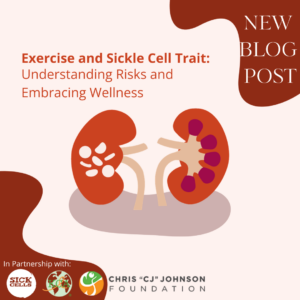Introduction
If you are reading this blog, you may already know about Sickle Cell Trait (SCT). For those who don’t, SCT is a genetic condition that affects approximately 300 million people worldwide and plays a role in various health concerns. But did you know SCT is also connected to a rare type of kidney cancer?
Over half a million people in the US live with kidney cancer, also known as renal cell carcinoma (RCC), and about 82,000 new cases will be diagnosed in 2023 alone. There are many different types of kidney cancer. However, one of the most aggressive of all kidney cancers is renal medullary carcinoma (RMC). RMC is a rare subtype of kidney cancer that primarily affects people with SCT. RMC is a rare, aggressive, and often fatal disease that accounts for less than 1% of all kidney cancer cases.
What’s concerning about RMC is that by the time it is diagnosed, the cancer has often metastasized to other organs and is classified as stage 4. RMC typically does not respond to the therapies used for most other kidney cancers and is one of the deadliest cancers, with an average survival of only 13 months after diagnosis. Ongoing research hopes to pinpoint exactly why RMC happens in some individuals with SCT.
It is already known that high-intensity exercise can sometimes lead to complications with red blood cells in people with SCT. The CDC assures that everyone, including those with SCT, can exercise regularly, but they do note some rare serious incidents, even fatalities, linked to SCT. If you have SCT, it is important that you drink half your body weight in ounces of water every day, eat a diet that promotes red blood cell health, start new activities slowly so your body has time to acclimate, and develop wider blood vessels, and steer clear of things like drugs and alcohol.
Recently, medical experts at the University of Texas MD Anderson Cancer Center have uncovered a new link between high-intensity exercise and RMC. “Our findings are consistent with the idea that high-intensity exercise is a risk factor for RMC in the setting of SCT,” said lead investigator Dr. Pavlos Msaouel, a clinician and cancer biologist at MD Anderson Cancer Center. “This does not mean that every person with RMC will have such exercise history nor that every person with SCT who regularly exercises at high intensity will develop RMC. But we now know for the first time of a risk factor – high-intensity exercise – that we can potentially modify and perhaps prevent RMC from happening in at least some people.”
This novel discovery brings many new questions and insights into this rare but serious condition. In this blog post, we’ll take a detailed look at this groundbreaking study, illuminating what it means for patients, healthcare providers, and anyone interested in learning more. So, if you’re a patient, a caregiver, or just curious, come along as we explore the complex link between SCT and RMC and the possibilities this new knowledge brings to prevention and care.
Understanding the Study: Unveiling the Connection
This research journey began with a critical question: Could intense exercise play a role in the development of RMC?
The researchers carefully examined data from individuals with RMC and compared it to a control group. The individuals diagnosed with RMC reported participating in higher levels of physical activity compared to those in the control group. High-intensity exercise or activities was defined as those where someone’s heart rate reached more than 80% of their maximal heart rate. Notably, these patients also had more skeletal muscle (SM) in their bodies, indicating they were probably more active overall.
Based on these findings, could intense physical activity somehow contribute to the risk of developing this rare and aggressive kidney cancer?
Many clues are indeed pointing in this direction. The study at MD Anderson was prompted by a general clinical observation of frequently reported high-intensity exercise among their RMC patient population. When compared to the general US population of black SCT individuals, the RMC group also included a significantly higher proportion of military service among patients. This study serves as a crucial starting point for understanding the complex interplay between exercise, kidney health, and the unique challenges posed by sickle cell trait.
The study extended its investigation to animal models, specifically mice engineered to have human SCT. The mice also experienced worse kidney health as a result of high-intensity exercise, particularly on the right kidney where – interestingly – humans often develop RMC. On the other hand, moderate-intensity exercise appeared to have a positive impact on kidney health in the animal models.
This finding underscores the importance of finding a balanced approach to staying active. It’s not about avoiding exercise altogether but about understanding the right levels of intensity that promote well-being without posing unnecessary risks.
This research opens doors to further exploration. The exact mechanisms connecting high-intensity exercise, renal medullary hypoxia (low oxygen levels in the kidney’s inner part), and the development of RMC are complex and require more research. In a subsequent study conducted by the same research group, fresh insights were uncovered that elucidate the molecular link between exercise-induced hypoxia and RMC. Hypoxia means that the body’s tissues are not getting enough oxygen to function properly.
Specifically, the researchers discovered that in individuals with SCT, hypoxia in the kidney’s renal medulla led to a decrease in the levels of SMARCB1, a key tumor suppressor gene and the principal genomic driver of RMC. This new knowledge reveals a type of domino effect – when people with SCT engage in high-intensity exercise, that can cause increased hypoxia (meaning less oxygen available for the kidneys), and lower SMARCB1 levels in the renal medulla. Insufficient SMARCB1 levels to suppress tumor activity may contribute to the development of RMC.
In conclusion, the study’s findings remind us of the significance of remaining informed, seeking answers, and fostering open discussions within our community. While the full picture is still forming, this research provides an essential foundation for understanding the connections between exercise and RMC. Understanding this association may open new avenues for personalized care and highlights the importance of considering factors like physical activity, diet, and family history in managing SCT. Knowing about this correlation is essential for individuals with SCT, healthcare providers, fitness professionals, and the broader community.
As we identify risk factors for RMC, we can be empowered to approach our routines with mindfulness and take steps toward healthier lives, all while considering the unique challenges that sickle cell trait introduces into the equation. This is among the priorities of both the Kidney Cancer Association (KCA) and the Chris “CJ” Johnson Foundation: to focus on individuals with all forms of kidney cancer, including rare types seen in individuals with SCT, to educate, build awareness, promote advocacy, resulting in greater public understanding and ultimately a cure for all forms of kidney cancer, including RMC.
Tips and Reminders
- Know Your Limits: If you have SCT, consult with healthcare providers to understand the right intensity level for your exercise routine.
- Stay Informed: Educate yourself about SCT, its risks, and how lifestyle choices can impact your health. Learn about risk factors and connect with organizations like the Kidney Cancer Association and the Chris “CJ” Johnson Foundation that advocate for awareness and support research in kidney cancer and RMC.
- Follow Recommended Guidelines: Consider guidelines from reputable organizations like the CDC, NATA, and NCAA for safe exercise practices if you are involved in athletic activities or rigorous professions.
- Support Research: Consider making a donation to support the work of organizations like KCA and Chris Johnson Foundation to fund cutting-edge research and help finding a cure for kidney cancer and RMC.
Closing
Don’t let anything hold you back from engaging in physical activities, no matter your level or intensity. Even if you have one of the genes responsible for hemoglobinopathies, you can still pursue a career as a professional athlete, enjoy sports recreationally, keep up with a physically demanding job, or stay fit with light exercise. The key is understanding the risks, including the very rare but present risk of RMC, and knowing how to manage them. If you’re a pro athlete or have a physically demanding job, don’t hesitate to talk to your healthcare provider. With proper monitoring for symptoms and regular check-ups, you can still pursue your passion. Early detection of even something as serious as RMC can make treatment more successful!
The potential connection between intense exercise and RMC in people with sickle cell trait (SCT) will likely be complicated and multi-layered. But it’s something we need to pay attention to, as it reveals ways we might be able to minimize risks and create personalized strategies for prevention. This isn’t just important for those with SCT – healthcare providers and researchers should also join in a collective effort to better understand and address these challenges for the sickle cell community.
You can read the scientific articles mentioned in this blog here:
https://doi.org/10.3390/cancers13236022
https://www.pnas.org/doi/abs/10.1073/pnas.2209639120
Call to Action
Let’s unite in the face of this new information. Share this knowledge with others, seek professional guidance if you or a loved one has SCT, and consider supporting ongoing research. Together, we can transform this understanding into meaningful change for those affected by SCT and RMC.
About the authors:
Salvatore La Rosa, PhD, is the Chief Scientific Officer of the Kidney Cancer Association
Ritchie Johnson, MBA, BSN, RN, is the President and Founder of the Chris “CJ” Johnson Foundation
Published October 2023

